NFTs and Gaming Lead the ETH Rally
We map out the basics of the NFT space, and assess the volume and demand metrics describing its meteoric growth.

ETH has continued its rally off the July lows, breaching $2,500 amidst increased network usage. This increased interest is primarily driven by the explosive growth from NFTs and gaming. ETH price has happily latched onto the coattails of NFTs as the upcoming London hardfork and EIP-1559 become secondary conversations in crypto.
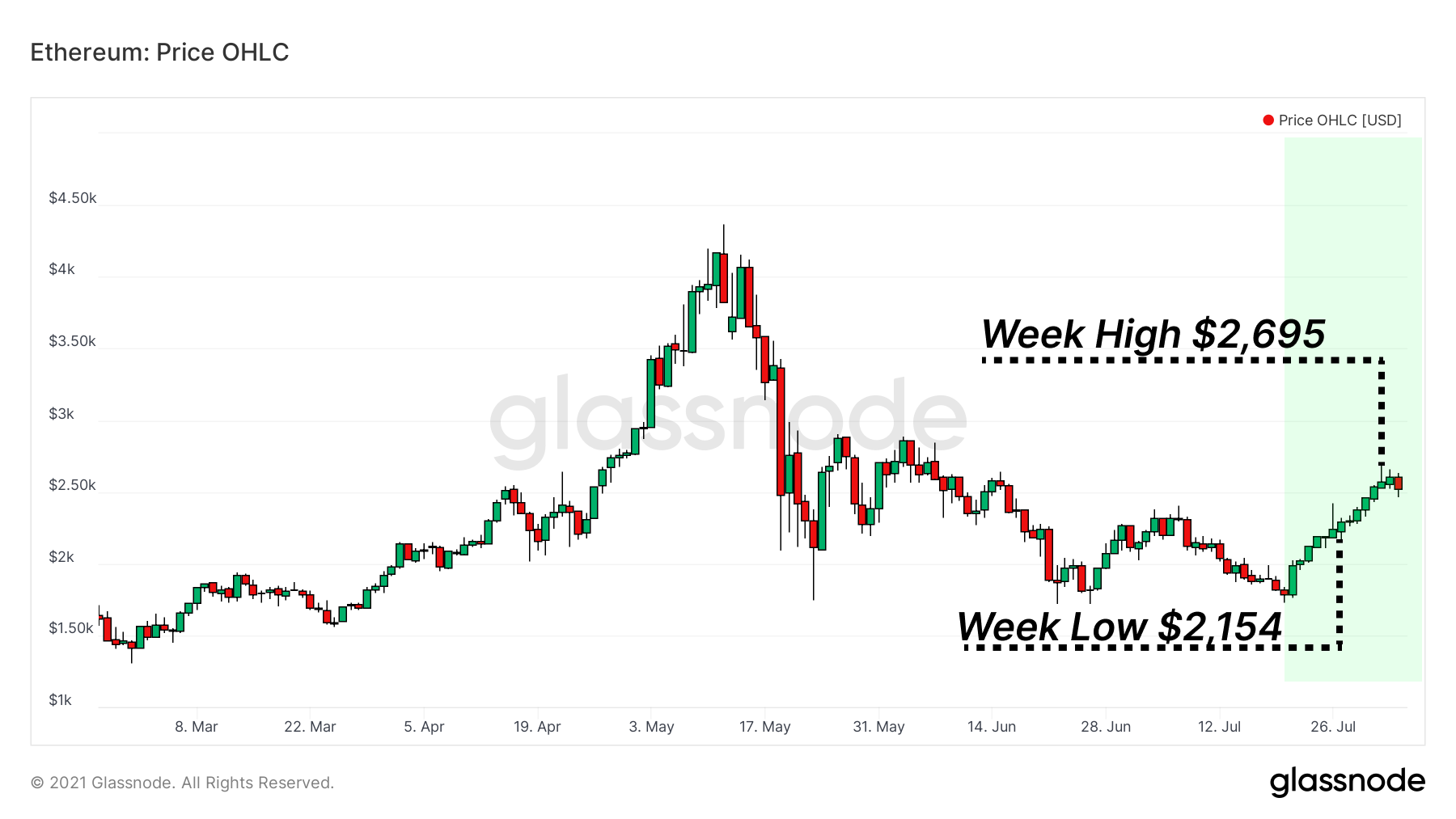
The rise of NFTs has temporarily left DeFi in their shadow, leaving every market participant wondering where NFTs goes next. In this piece we will explore:
- Quick intro to NFTs and their history.
- Price explosion of the past few months in NFT collections.
- Growth of OpenSea Exchange and broad metrics on NFT traders and their activity.
- The rise of NFT gaming.
Since DeFi Summer, the overwhelmingly dominant source of network usage has been Uniswap-V2. Uniswap remains a dominant gas guzzler, but in the past few weeks we've regularly seen hours or even days where Uniswap is 2nd or 3rd in total gas consumption, firmly behind Non Fungible Token (NFT) projects, primarily the launch of collections. See below the daily consumption for August 2nd as an example.
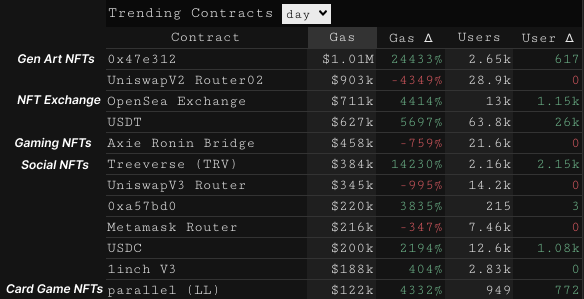
This blip in gas consumption still pales in comparison to peak activity from DeFi Summer and onward. Back then over 800,000 addresses were interacting with Uniswap monthly, these days that number is down to under 340,000. That said, OpenSea and other NFT exchanges are right at the heels of many major crypto projects for active addresses.
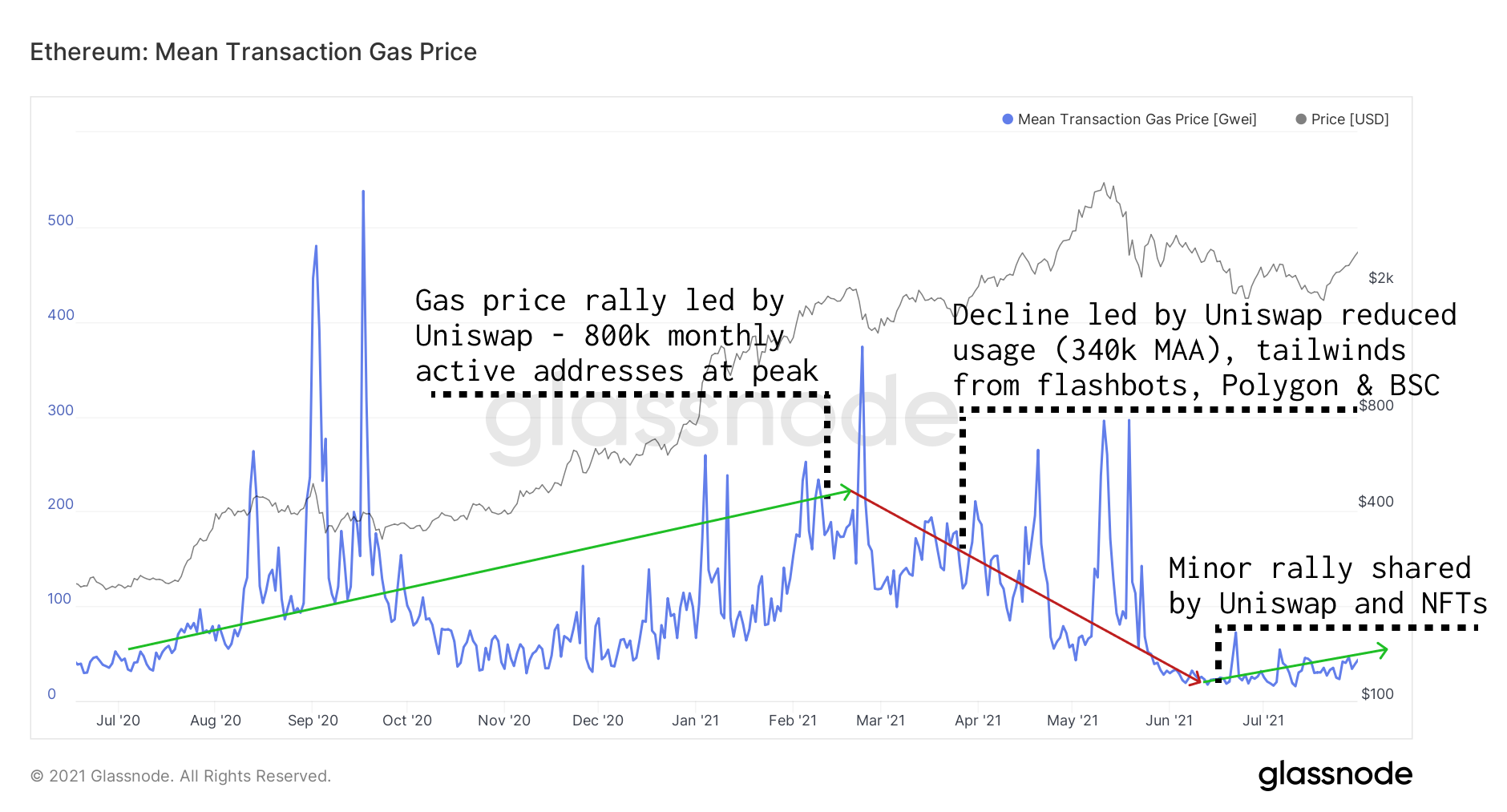
NFTs are different from normal crypto tokens in that they are non-fungible, meaning each token is unique and valued independently. Most Ethereum NFTs adhere to ERC-721, Ethereum's non-fungible token standard. On the back of this standard, a whole generation of 1/1 art and 1/x themed releases have been launched to great success.
Art and collectibles as NFTs marks a new era for the exchange of items which previously were very private and non-social. No longer does the buyer/seller have to wait for slow centralized parties to list their assets, ship and trade, organize an auction day, or approve their sales through centralized entities. NFTs allow trades to go peer to peer, exchanging ownership of these collectibles 24/7. The primary venues for trading NFTs include OpenSea Exchange and Rarible.
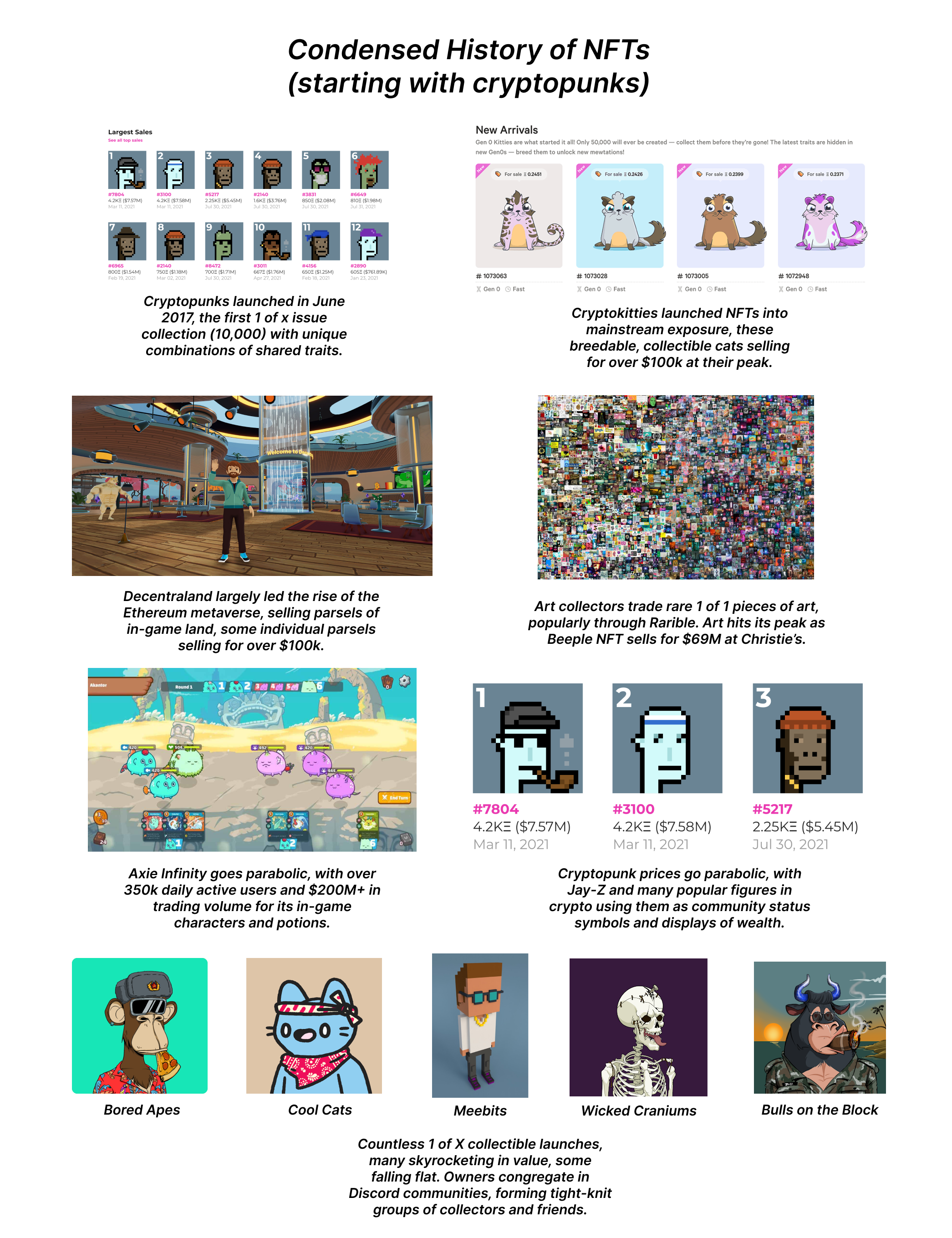
1/1 art are those pieces artist mint on the blockchain as single issue NFTs. They are solo drops, sometimes issued as more than one copy of the same piece. 1/x collectibles are collections of NFTs with unique properties, usually adhering to some theme. Cryptopunks is the most valuable of these 1/x collectibles.
What gives these NFTs value?
- Value from status, scarcity, community, and reputation.
- A (relatively) liquid marketplace for traders to interact and engage in price discovery 24/7.
The issues in each collection with the rarest traits often trade for the highest prices, traded and denominated in ETH. The rarity adds interest in the NFT and status for the holder. Note the meteoric rise in average price of Cryptopunks. They've exploded, with countless popular figures in and out of crypto holding and showing off their punks.
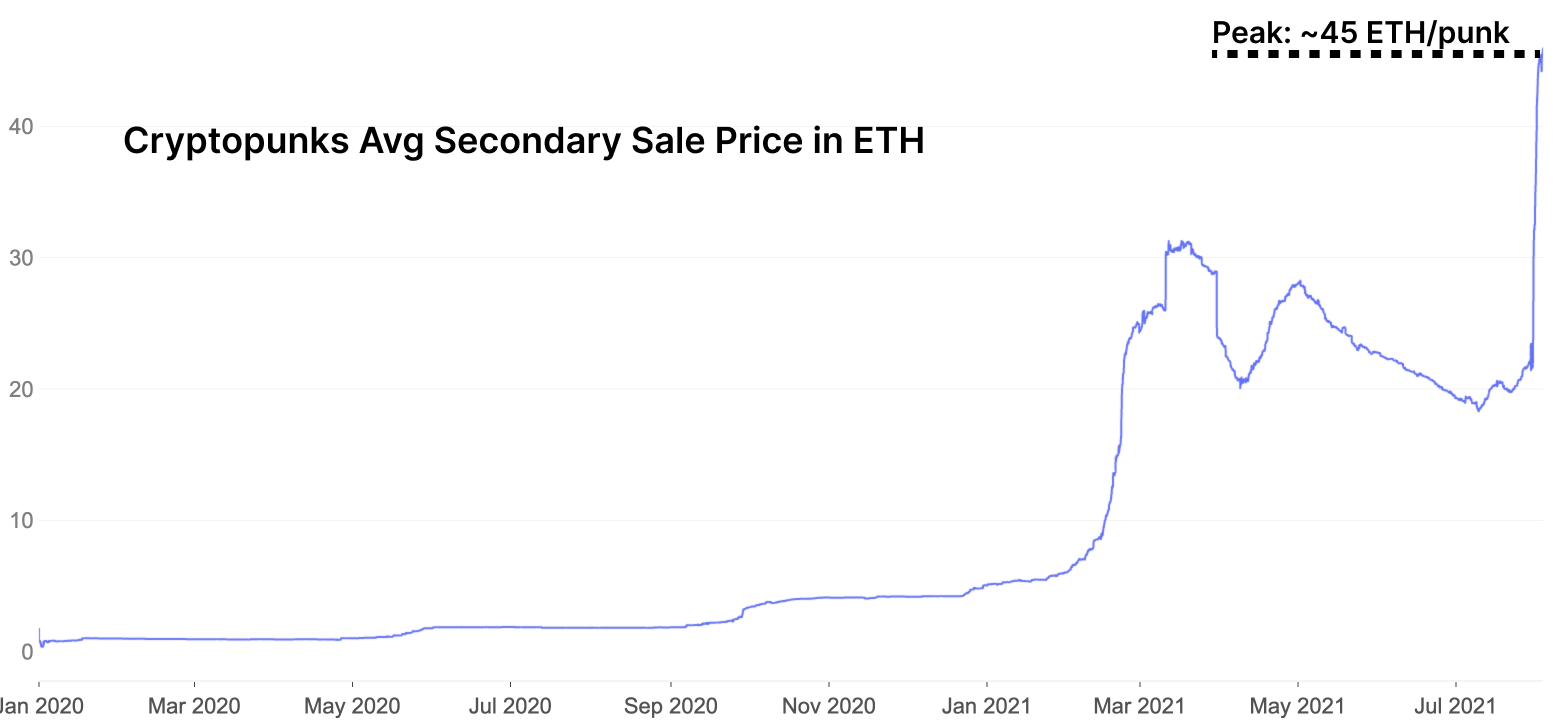
Many savvy NFT investors will keep up with the hottest drops, tracking new projects and seeking to understand which will gain the interest of the NFT community. The projects with the strongest price growth often have large Discord communities where owners of NFTs from the collection discuss their pulls and make friends over their shared interest. Take Bored Apes Yacht Club as an example.
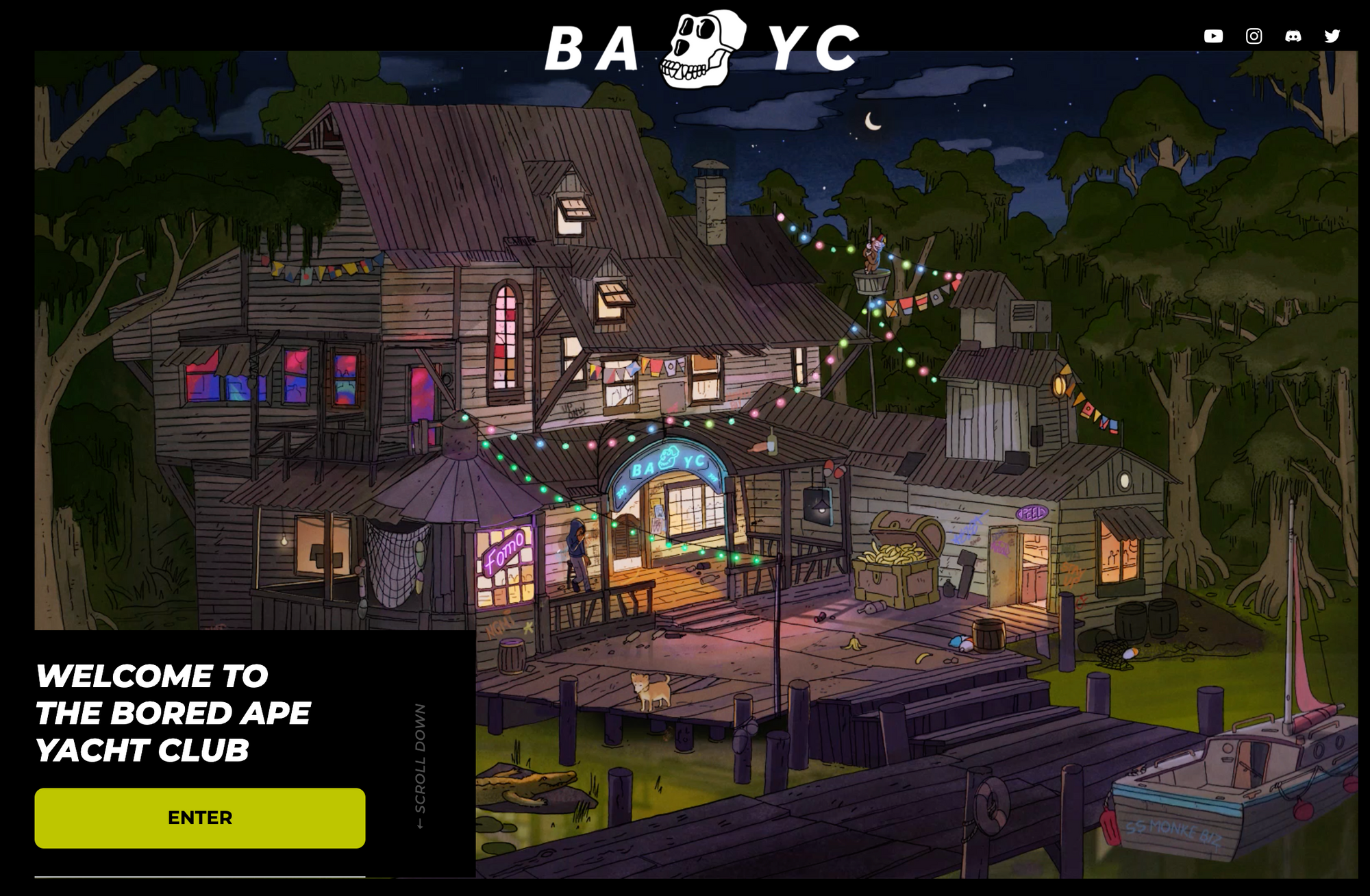
Bored Apes launched at the end of April, just three months ago. Investors in NFTs like Bored Apes mint their NFTs from a limited run. The project typically has a launch date upon which any interested party can race to mint an NFT of their own from the limited supply. Once the cap has been reached, no more are available.
The standard minting prices for each piece from collections has typically hovered from 0.02 ETH to 0.08 ETH. Once these NFTs are all minted they can only be purchased on secondary markets like OpenSea. Bored Apes sold their 10,000 unique apes for 0.08 ETH each. Since the launch, secondary prices have far exceeded that 0.08 ETH sale price.
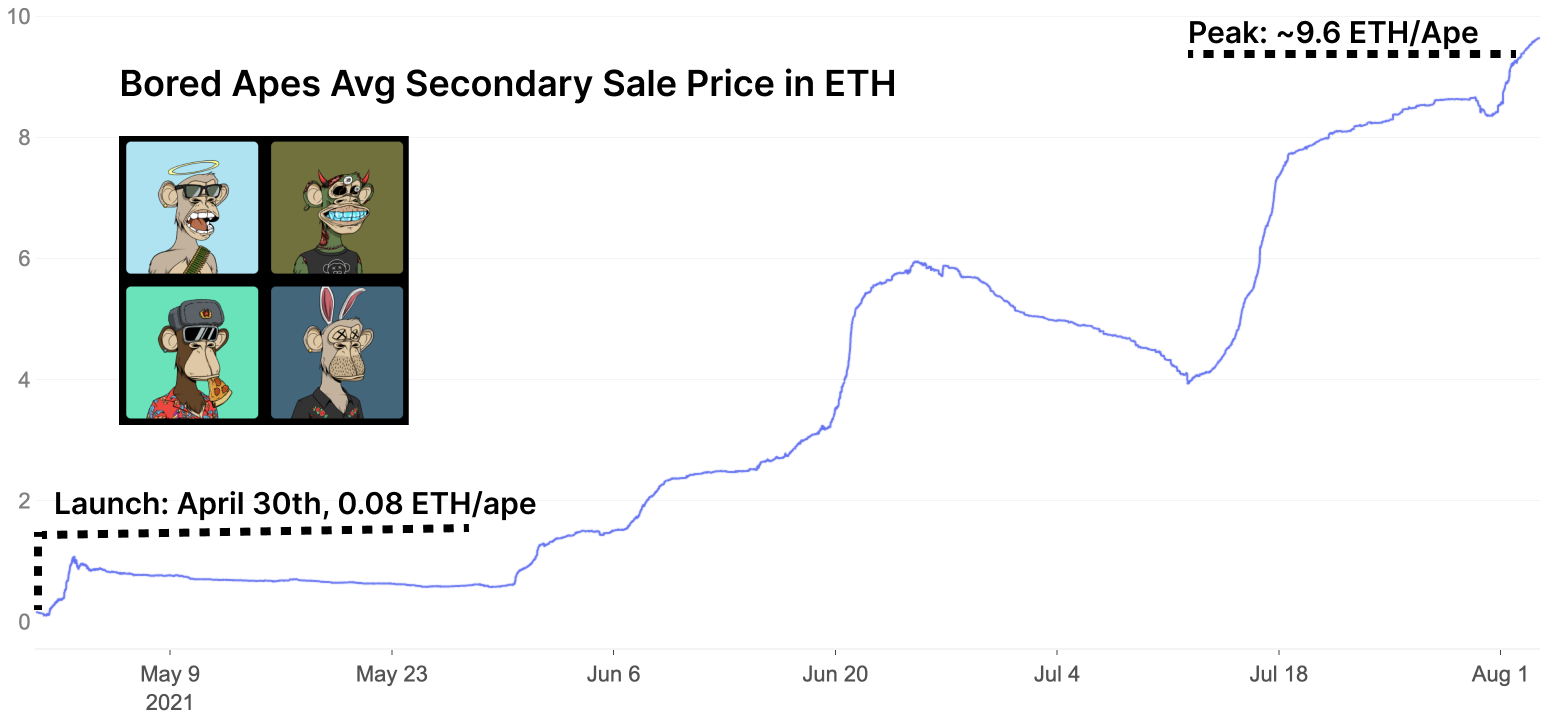
OpenSea has watched its usage explode in 2021. This secondary market for NFTs supports all sorts of configurations for their exchange. Creators of NFTs can even code royalties into their projects, making it so every time their NFT is traded they receive a cut of the trade. Additionally, OpenSea supports varied types of sales. Fixed prices and variable styles of auctions are the most popular.
The usage explosion in July and now August is leading to projections for a record month should usage continue at this pace; this chart looks quite silly, but it reflects the run rate for USD volume of Open Sea for the month of August after doing $100M in just a few days. How often do you see growth of this magnitude?
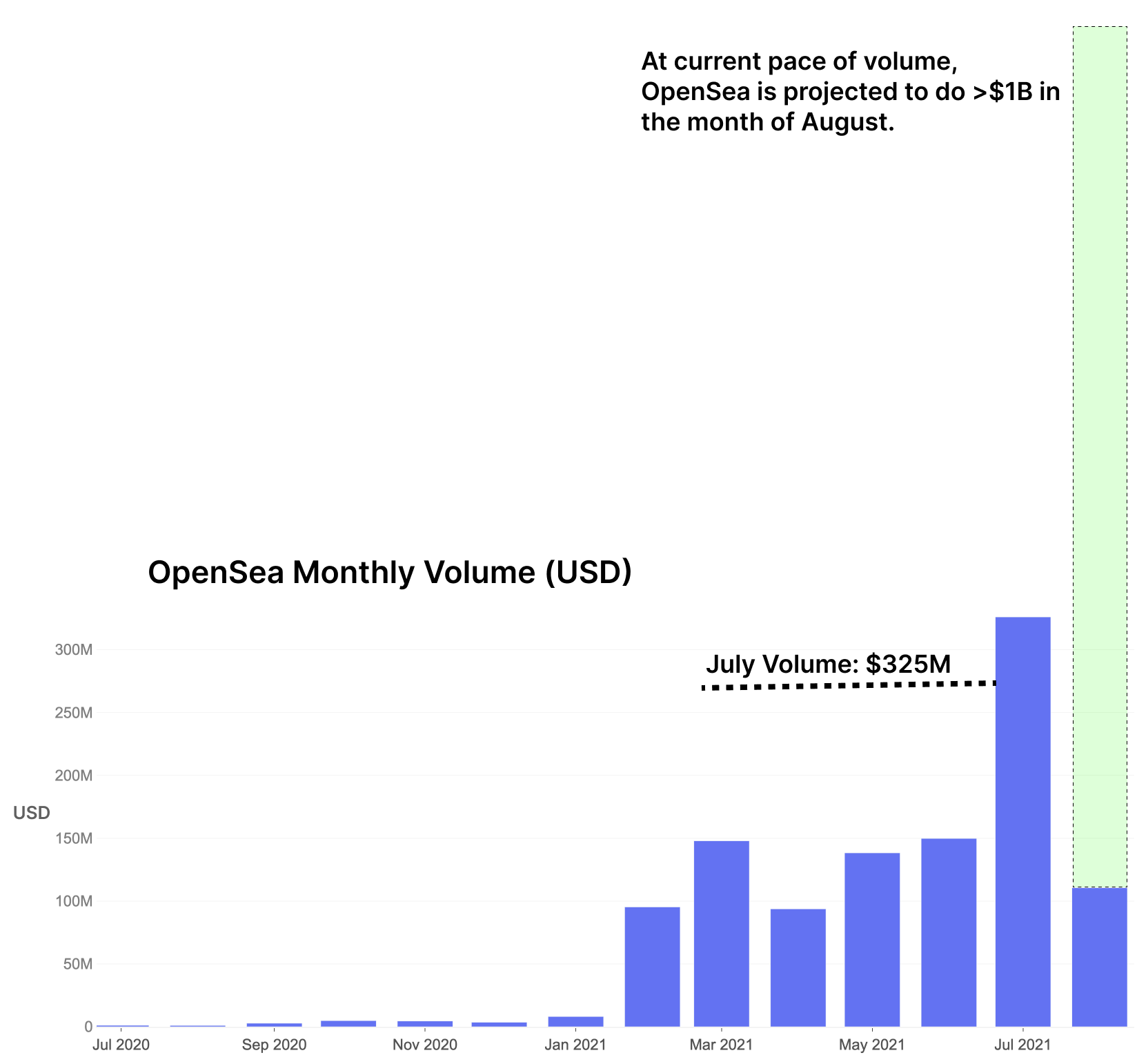
This absolutely wild growth on OpenSea has been driven by enormous user growth and widespread interest in the space. 63,000 addresses interacted with OpenSea in the month of July. Three days into August and already 28,000 addresses have interacted with the exchange. Explore below the sheer scale of how the last three days have exploded in NFT interest based on number of addresses interacting with OpenSea. For comparison, popular DEX Sushiswap had 34,000 addresses interact with it over the entire course of July.

NFTs in Gaming
In other areas of explosive growth... Over the last few months crypto gaming hopped onto the scene with Axie Infinity growing market cap of its token $AXS over the course of July from $200M to $2B market cap. It did this on the underlying game seeing massive adoption.
Axie Infinity plays a lot like Hearthstone meets Pokemon. Players use their collectible Axies with different traits to face off. Before the match players position their Axies. In-game the players choose when to allocate energy to their Axies. Axies then throw skills at opponents which are directed based on positions set before the game (thanks for Axie scholar FluctusLux for the explanation).
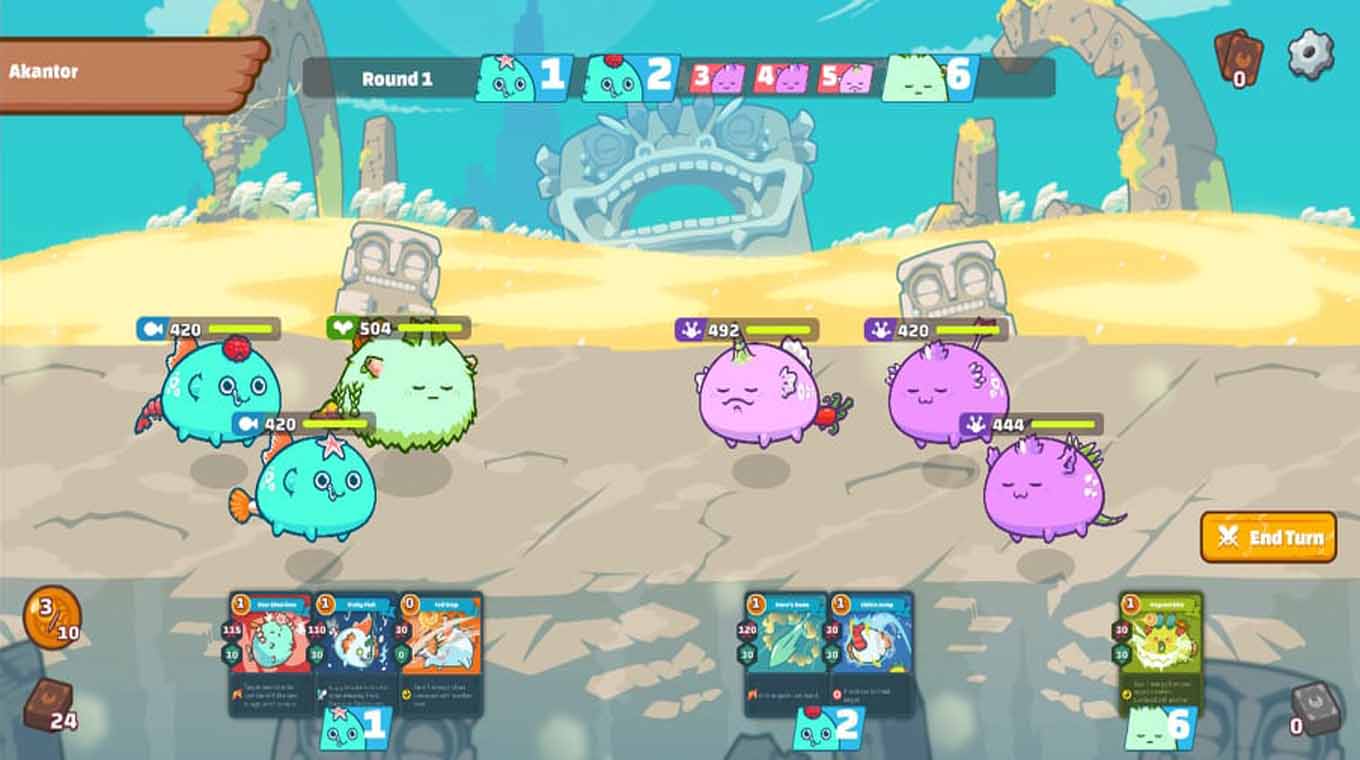
Hints of the project's adoption showed up in gas usage all through the course of May/June. In July it continued its historic growth, doing over 250,000 peak daily active users and over $500M+ in 30-day trading volume for the game's playable characters (axies).

The exchange of Axie NFTs on secondary markets has also been explosive. 30-day volume on OpenSea and Axie Marketplace have exceeded $700M on over 230k traders and 1.4M cumulative sales.

Various other games have recently announced or launched. Parallel is another popular release which recently launched its first run of cards for its upcoming card game. The cards are special early run cards with unique designs. The same cards will be purchasable at later dates for usage in-game but be less fancy than the initial run cards. Think of it like trading a holographic Charizard vs a normal Charizard (explanation from @DefiDuck_Karoo). The holo holds more value for its rarity and status.

Various games like Parallel are using NFTs to grow interest in their projects. Ember Sword and Illuvium, both RPGs, are two other well capitalized soon to release games that use NFTs as a central mechanic of their game.
All sorts of creative ideas for how to incorporate scarcity and money games into NFTs can be run. For example, ownership of an in-game item from Parallel called the catalyst drive can be paired with another item to earn rewards. Unique interactions between users and NFTs can be codified in smart contracts to run all sorts of new experiments in user attention.
Closing Thoughts
We can expect more and more NFT projects to continue to launch with varying legitimacy and staying power. Art and culture move fast, and the interesting NFTs of today can quickly be forgotten about tomorrow. While we can't quantify status, we can quantify prices, trading activity, # of holders, size of communities, and do our best to understand demand across the NFT space.
The existence of NFTs is so tightly integrated with the culture of DeFi that we would be remiss to ignore it. And increased interest in NFTs is just as plausible a catalyst for ETH price as any other usage on the network. How capital flows from DeFi <--> ETH <--> NFTs and back is anyone's guess.
Uncovering Alpha
This is our weekly segment that briefly discusses some of the most important developments of the prior and upcoming week.
Enthusiasm for building continues, regardless of price or fundamentals.
- Much anticipated token burn mechanism EIP-1559 is on-deck. London hard fork expected for August 4th, marking a monumental moment in popular Ethereum discourse.
- Compound governance votes to add MKR, AAVE, SUSHI, YFI. Will be interesting to see how the SUSHI market sees adoption vs the xSUSHI market in Aave.
- Alpha boosted yields alongside Alpha Homora v2. Tiered/boosted rewards for token holders go into effect for staking ALPHA.
- Synthetix exchange Kwenta launches on Optimism. Kwenta is the primary exchange for synths. It is hoping for adoption on L2.
- Thales goes live. Highly anticipated binary options on top of Synthetix gets launched. Airdrop for SNX stakers anticipated.
- Dopex on testnet. Highly anticipated options exchange Dopex has found its way to the Arbitrum testnet. Dopex hopes options adoption on L2 will find some traction after very limited liquidity for options existing on L1.
- ArcherDAO rebranding to Eden Network. The MEV protection protocol issues in a new era, launching its token with staking and liquidity mining. Staking and liquidity mining live with the rest to launch on August 5th.
- Fuse permissionless pools going through audit. Permissionless lending pools that anyone can create with the parameters of their choosing. Plus the potential to add private pools limited to whitelisted addresses by the pool creators. Meanwhile, Rari Capital has deployed Fuse on Optimism, waiting for their project to be whitelisted. They have numerous other products being built for Optimism, including Nova, a product to transact on L1 from L2.
- Andre announces Fixed Forex, a new stable product. Decentralized fiat on/off ramps, starting with attracting liquidity on-chain for ibEUR. Andre stated liquidity is needed on-chain first, fiat ramps come second.
- Follow us and reach out on Twitter
- Join our Telegram channel
- For on–chain metrics and activity graphs, visit Glassnode Studio
- For automated alerts on core on–chain metrics and activity on exchanges, visit our Glassnode Alerts Twitter
Disclaimer: This report does not provide any investment advice. All data is provided for information purposes only. No investment decision shall be based on the information provided here and you are solely responsible for your own investment decisions.

